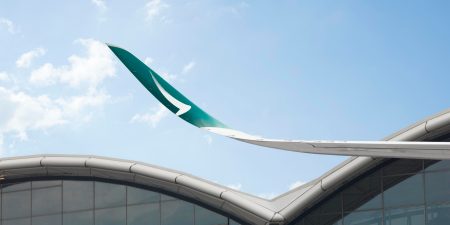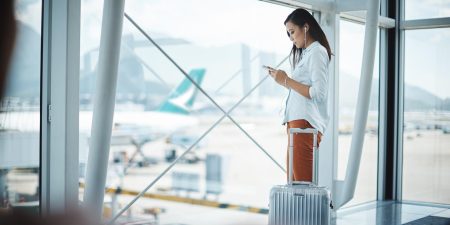
Cathay Pacific releases traffic figures for July 2022
Cathay Pacific carried a total of 219,746 passengers last month, an increase of 306.2% compared to July 2021, but a 93.3% decrease compared to the pre-pandemic level in July 2019. The month’s revenue passenger kilometres (RPKs) increased 348.4% year-on-year, but were down 89.4% versus July 2019. Passenger load factor increased by 44.7 percentage points to 73.3%, while capacity, measured in available seat kilometres (ASKs), increased by 74.6% year-on-year, but decreased by 87.6% compared with July 2019 levels. In the first seven months of 2022, the number of passengers carried increased by 162.8% against a 6.3% decrease in capacity and a 189.8% increase in RPKs, as compared to the same period for 2021.
The airline carried 100,714 tonnes of cargo last month, a decrease of 17.2% compared to July 2021, and a 40.7% decrease compared with the same period in 2019. The month’s cargo revenue tonne kilometres (RFTKs) decreased 27.5% year-on-year, and were down 42.6% compared to July 2019. The cargo load factor decreased by 10.8 percentage points to 71%, while capacity, measured in available cargo tonne kilometres (AFTKs), was down by 16.4% year-on-year, and was down by 48.9% versus July 2019. In the first seven months of 2022, the tonnage decreased by 6.6% against a 28.3% drop in capacity and a 34.2% decrease in RFTKs, as compared to the same period for 2021.
Travel
Chief Customer and Commercial Officer Ronald Lam said: “We continued to add more passenger flight capacity in July in light of the Hong Kong SAR Government’s progressive adjustments to travel and quarantine restrictions. Capacity increased by 24% compared to June, although it remained low at 12.4% of the pre-pandemic level. Passenger volume increased to an average of over 7,000 per day. Meanwhile, passenger load factor reached 73.3% – the highest it’s been since the start of the pandemic.
“The additional capacity we were able to operate provided enhanced connectivity options for our customers transiting through the Hong Kong hub, with demand from the Chinese Mainland to Australia and the US particularly robust. We also saw strong demand on our UK routes, especially from students returning to Hong Kong. As many of these flights were full, some of this student traffic shifted to our other European gateways such as Amsterdam and Frankfurt. Meanwhile, we were able to resume carrying passengers to Fuzhou, Nanjing and Wuhan in the Chinese Mainland again following adjustments to local capacity restrictions.
Cargo
“Cargo demand remained flat in many of our key markets in July as we entered the traditionally quieter summer months for air cargo. Tonnage decreased month on month across most markets, reflecting reduced cargo flight capacity due to weather related cancellations as well as ongoing operational restrictions which impacted the July schedule. The major impact of these challenges was seen on our Indian and the Americas routes, whilst capacity on our European routes grew marginally.
“Overall, our cargo volumes dipped by about 4% month on month against an approximately 7% decrease in capacity. We operated 51% of our pre-pandemic cargo flight capacity last month. Meanwhile, load factor was 71%.
Outlook
”Looking ahead on the travel side, the latest adjustments to quarantine arrangements for passengers arriving in Hong Kong are expected to have a positive impact on inbound traffic as well as leisure travel among Hong Kong residents. Student traffic to the US and UK is also expected to provide our travel business with a strong boost in August and September. However, our ability to add more passenger flight capacity will remain limited unless the restrictions on our aircrew are lifted.
”Regarding cargo, we expect to operate a full freighter schedule in August and going forward, complemented by regional cargo-only passenger flights and more belly capacity provided by our additional passenger services. However, long-haul cargo-only passenger flights will be limited. The situation involving cross-border trucking services between Shenzhen and Hong Kong remains uncertain, and we will continue to monitor the situation closely and adapt accordingly. We are cautiously optimistic about a solid seasonal winter peak season, although this is anticipated to be less pronounced than the one we experienced in 2021 in light of the current global economic environment."
The full July figures and glossary are on the following pages.
CATHAY PACIFIC TRAFFIC | JUL 2022 | %Change VS JUL 2021 | Cumulative JUL 2022 | %Change YTD |
| RPK (000) |
|
|
|
|
| - Chinese Mainland | 44,605 | 114.5% | 182,108 | 124.7% |
| - North East Asia | 21,024 | 136.9% | 48,195 | 37.3% |
| - South East Asia | 91,744 | 380.5% | 193,883 | 74.7% |
| - South Asia, Middle East & Africa | 32,241 | 460.0% | 58,463 | 563.8% |
| - South West Pacific | 174,524 | 792.0% | 418,949 | 378.9% |
| - North America | 537,162 | 245.6% | 1,216,529 | 136.6% |
| - Europe | 434,402 | 535.3% | 1,027,221 | 314.6% |
| RPK Total (000) | 1,335,702 | 348.4% | 3,145,348 | 189.8% |
| Passengers carried | 219,746 | 306.2% | 555,208 | 162.8% |
| Cargo revenue tonne km (000) | 546,796 | -27.5% | 2,669,628 | -34.2% |
| Cargo carried (000kg) | 100,714 | -17.2% | 626,591 | -6.6% |
| Number of flights | 1,723 | 8.2% | 9,332 | 17.3% |
CATHAY PACIFIC CAPACITY | JUL 2022 | %Change VS JUL 2021 | Cumulative JUL 2022 | %Change YTD |
| ASK (000) |
|
|
|
|
| - Chinese Mainland | 100,575 | 40.9% | 591,063 | 83.0% |
| - North East Asia | 75,357 | 43.0% | 178,733 | -38.1% |
| - South East Asia | 158,863 | 91.9% | 365,433 | -31.3% |
| - South Asia, Middle East & Africa | 65,893 | 135.4% | 133,478 | 176.9% |
| - South West Pacific | 248,629 | -11.6% | 729,164 | -40.0% |
| - North America | 674,713 | 83.2% | 1,611,118 | -22.6% |
| - Europe | 498,625 | 213.5% | 1,272,475 | 76.2% |
| ASK Total (000) | 1,822,655 | 74.6% | 4,881,464 | -6.3% |
| Passenger load factor | 73.3% | 44.7%pt | 64.4% | 43.6%pt |
| Available cargo tonne km (000) | 770,243 | -16.4% | 3,571,458 | -28.3% |
| Cargo load factor | 71.0% | -10.8%pt | 74.7% | -6.7%pt |
| ATK (000) | 944,872 | -7.4% | 4,038,948 | -26.2% |
Glossary
Terms:
Available seat kilometres (“ASK”)
Passenger seat capacity, measured in seats available for the carriage of passengers on each sector multiplied by the sector distance.
Available tonne kilometres (“ATK”)
Overall capacity measured in tonnes available for the carriage of passengers, excess baggage, cargo on each sector multiplied by the sector distance.
Available cargo tonne kilometres (“AFTK”)
Cargo capacity measured in tonnes available for the carriage of freight on each sector multiplied by the sector distance.
Revenue passenger kilometres (“RPK”)
Number of passengers carried on each sector multiplied by the sector distance.
Cargo revenue tonne kilometres (“RFTK”)
Amount of cargo, measured in tonnes, carried on each sector multiplied by the sector distance.
Ratio:
Revenue passenger kilometres/
Cargo revenue tonne kilometres
Passenger/Cargo load factor = ------------------------------------------------------------
Available seat kilometres/
Available cargo tonne kilometres










